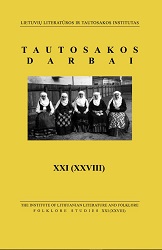KELIOS PASTABOS APIE MĮSLIŲ MINIMĄ
SOME REMARKS REGARDING RIDDLING
Author(s): Aelita KensminienėSubject(s): Customs / Folklore, Phenomenology
Published by: Lietuvių literatūros ir tautosakos institutas
Keywords: Riddles; Lithuanian folklore; tradition;
Summary/Abstract: The article consists of two parts. In the first part, on the basis of the ethnographical data of Lithuanians and their neighboring peoples, the author of the article discusses functioning of riddles in people’s everyday life and customs, while in the second part, she concentrates on riddles or similar phenomena, as they are depicted in other kinds of Lithuanian folklore. The author of the article aims at pointing out the typical time and place of riddling, its participants and, inasmuch as possible, the circumstances and intentions. In the focus of analysis there are the purposefully created, and most probably traditional, situations of riddling. The available ethnographic data is rather scant in this respect. According to the analyzed materials, it seems that in Lithuania and its northern neighboring countries riddling most typically took place during the cold period of the year, in closed premises, usually in the course of the social evenings, i.e. while working together. Two age groups of the riddle performers may be tentatively discerned: riddling either took place inside the youth groups, or was performed by grown up / elderly people for children. It seems that time for flax processing and spinning, riddling and wedding tended to coincide. Wedding in Lithuania had probably been conceived as one of the youth maturity rites. Thus connections between riddling and wedding rituals (conceived as a prolonged process) appear very probable; such an assumption is also supported by the wedding songs with riddle insertions and by the wedding intentions apparently presented by riddles in fairy tales. In folksongs, skills in answering riddles are regarded as a required qualification for a mature girl (less frequently, for a boy), whereas in fairy tales, ability to compose an unanswerable riddle is perceived as an indication of resourcefulness and cleverness. In both cases the riddling skills signify eligibility for marriage. Riddles used in folksongs and in fairy tales are distinctly different; at the moment, they are even ascribed to different subgroups of the genre.
Journal: Tautosakos darbai
- Issue Year: 2005
- Issue No: 29
- Page Range: 67-85
- Page Count: 19
- Language: Lithuanian

